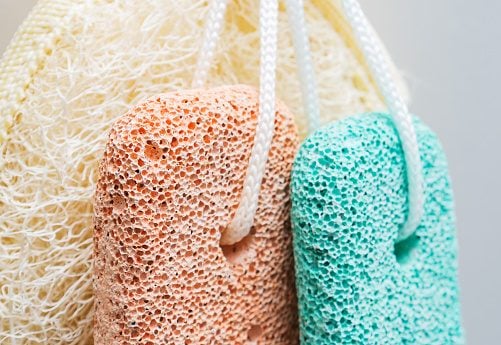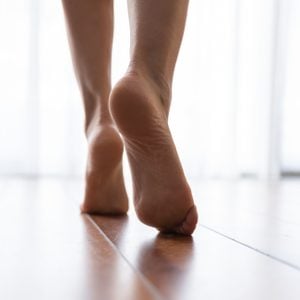The 6 Dos—and 4 Don’ts—of Using a Pumice Stone
Updated: May 04, 2021
To get the smooth, soft feet of your dreams, follow this expert advice—including how not to use a pumice stone.
Pumice stones for home pedicures
With pandemic restrictions in place over the past year, many people have been forgoing professional beauty care in favor of DIY treatments. The at-home haircuts? Probably not the greatest idea. The home-based pedicures, on the other hand, were a stroke of genius.
“I have treated a lot of new clients who were forced to start caring for their own nails and feet because of the coronavirus shutting everything down,” says Marcela Correa, licensed medical pedicurist and owner of Medi Pedi New York City. And, sure, many of us started a DIY pedicure routine because in-person service was out of the question, but it also provided a pretty great opportunity for self-care.
One of the most commonly used tools for at-home spa treatments (and pedicures in particular) is a pumice stone. You’ve probably seen one of these—might’ve even used one without being entirely sure what it is.
So let’s find out what these stones are and how to use them on your feet.
Where does a pumice stone come from?
Turns out, the miracle foot tool is actually a volcanic rock.
“A pumice stone is a natural stone that was created by the union of water and lava. The boiling lava cooled when water mixed into it, releasing gases that created a slab with holes,” explains Natalie Aguilar, a dermatological nurse and celebrity aesthetician. “They come in many shapes and sizes and have multiple household uses, from body care to scrubbing grease off a stove.”
“It’s great that people are starting to pay more attention to their feet,” Correa says. “It’s important, however, to make sure they are getting the proper education on the dos and don’ts.” (More on those later.)
 What to look for when buying a pumice stone
What to look for when buying a pumice stone
The first thing to know is that different types of pumice stones have different uses.
“A flatter stone is best used for larger areas, while a round stone works best to contour certain edges, like the side of the foot,” says celebrity manicurist Deborah Lippmann. “I find that a stone with a handle really helps with the hard-to-reach areas and is also great for the nail beds and cuticle area. Stones that have a rough and smooth side allow you to scrub and smooth with one tool.”
Celeste Hilling, founder and CEO of skin care company Skin Authority, says that most stones purchased through a beauty supply store or drugstore are fine. “We usually recommend a double-sided stone, which has a rougher side as well as a smoother side, so you can vary pressure and resurfacing based on the area of the feet,” she says.
Some pedicurists prefer using natural stones. “Not only is it better for the environment, I find they work better,” says Amber Johnson, an aesthetician and founder of Facial Lounge, a spa in Corona Del Mar, California.
How to use a pumice stone
“Pumice stones are a preferred option for at-home use in the shower or bath to alleviate dry, calloused feet and toes,” says Tia Delponte, owner of Tia’s Corner and an aesthetician at Color Up Wellness Center.
She recommends using a hard pumice stone to smooth the cracked and scaly areas of the feet. For the bottom of the feet and the tips of the toes, she prefers a softer pumice.
The key is to soak your feet first. That’ll soften your skin enough that you can slough off dead cells—without hurting your foot. “The reason most nail salons soak the feet is to remove hardened skin that forms on the bottom and sides of our feet easily, and without hurting the skin or causing pain,” Correa says.
Many nail salons opt for pumice stones over metal graters, says Correa. They’re gentler on your skin, whereas metal graters can cause cuts and lesions to the feet when used improperly.
Potential dangers
“I love a great pumice stone because it’s a simple and effective way to get rid of dead skin,” says Lippmann. “As long as you exercise caution when using them, they are safe.”
The caution part of her statement? Yeah, that’s important. Though pumice stones are often safe for most people, there are a few issues you need to be aware of.
Bacteria
As much as you want smooth feet, you probably aren’t too keen on introducing bacteria to your skin in the process. So the golden rule of using a pumice stone: clean it! (More on how to clean it later.)
If you don’t properly clean your stone, it can breed bacteria, says Delponte. “The biggest concern with using a pumice stone is making sure that it doesn’t collect bacteria,” she says. “It’s important to clean after every use with a scrub brush and leave the pumice stone out to dry in between uses.”
Sharing a pumice stone with another person (a big no-no) is another way you increase the chances of bacterial growth.
Pumice burn
Lippmann cautions against overusing pumice stones—you might remove too much skin.
Delponte agrees, saying over-exfoliation can have some pretty painful consequences. “When that happens, it is called ‘pumice burn’ and will leave your skin exposed and tender, creating pain while walking,” she says.
The best way to use a pumice stone is lightly (there’s no need to scrub like you’re scouring a food-crusted cooking dish) and more often.
Scratches and tears
Be mindful about where you use the pumice stone. Steer clear of soft skin, like the stuff on the top of your foot, your toes, and the ball of your foot.
In general, if your feet are sensitive or have thinner skin, you should be cautious, says Peterson Pierre, MD, a dermatologist and founder of the Pierre Skincare Institute.
“Pumice stones should never be used on areas of thin skin,” he says. “You should focus primarily on calluses and corns typically found on hands and feet. There’s no point in being overly aggressive: it won’t make your results any better, and you may cause wounds if you’re not careful.”
You can also harm your skin by using it improperly. “Using a pumice stone dry may damage your skin,” she says. It’s best to use a pumice stone after a bath or shower, when your feet are wet.
Certain medical conditions
Hilling warns that people with certain conditions should avoid pumice stones. “When used correctly, pumice stones are generally safe,” she says. “However, we don’t recommend use for anyone who is on blood thinners, has diabetic ulcerations, or [has] poor circulation. These conditions make someone more susceptible to bleeding or an infection as a result of use.”
In fact, some medical doctors say people with diabetes (whether or not they have foot ulcers) should avoid foot exfoliation altogether. And definitely skip this tool if you have nerve damage or a loss of sensation in your feet. If you have numbness, Hilling says, you may not feel the pressure. That can cause you to rub too deeply and injure your skin.
Don’t use a pumice stone (or any other exfoliator) over cuts, scrapes, or other wounds. “You should avoid any areas with lesions [or] ulcers,” says Hilling. “You also want to avoid cuts or other areas which can get infected.”
Instead, Hilling recommends a leave-on peel that will dissolve layers of dead skin. You can check out these 10 best foot peel masks to start.
Where to use a pumice stone on your foot
If your feet have patches of dry, thickened skin, a pumice stone may be just what you need. It’s particularly effective at removing rough patches of skin, such as the stuff that tends to form on the heels. “It’s best to use it on thicker skin, like calluses,” says Johnson.
How to use a pumice stone
First things first: make sure your pumice stone is thoroughly clean, says Lippmann. Wet the stone (or let it soak in warm water while you’re soaking your feet). “We always recommend to never use the stone dry,” says Hilling.
From there, follow these steps:
- Soak your feet in lukewarm water for five to 10 minutes. (Or exfoliate after a bath or shower.)
- Remove your feet. Pat them dry.
- Apply the wet stone to the area. Using light pressure, rub in a circular motion until you see the dry skin removed.
- Rinse your feet, then pat them dry.
- Apply a moisturizer (Hilling suggests an alpha hydroxy acid cream; Johnson loves lanolin moisturizers) or moisturizing oil to maintain softness.
- Wash your pumice stone, then lay it out to dry.
“You can repeat the steps a couple of days in a row until you get to the smoothness level, and then once a week to maintain,” says Hilling.
How should you care for the pumice stone?
By following these simple tricks, you can make sure your pumice stone stays clean and doesn’t transfer bacteria to your feet.
Store it properly
Think of the darker corners of your shower and how they begin to mildew if you don’t keep them clean. Your pumice stone has the same bacteria-breeding potential, so don’t leave it in the shower.
“Every stone has a different protocol to disinfect. I tell people not to keep the stones in a dark, wet place like the shower,” Johnson says. Instead, store your stone in a dry place.
Clean it thoroughly
There are different ways to clean your pumice stone, but the most important thing is that you do it every time you use it. Skip cleanings, and your stone can breed bacteria. Gross.
“It’s really important to always clean it after every use since bacteria can grow on the surface of the stone,” says Lippmann. “A bristle brush is a great way to scrub dead skin off the stone, but do so under running water and with a little soap.”
Hilling likes to clean her stones after each use with an antibacterial cleanser.
Want a deeper clean? Delponte recommends spraying pumice stones with 70 percent alcohol to make sure there is no chance of bacterial growth.
Or try Lippman’s deep-cleaning tactic: “Boil your pumice stone in hot water for five minutes,” she says. Johnson uses this method, too, but she says it’s important to follow the directions of the brand you bought.
Once your stone is clean, let it air dry completely before reusing. Only once it’s completely dry can it be stored in a dry, closed area.
Replace it regularly
“Pumice stones will wear down over time, becoming too smooth to remain effective,” says Lippmann. “If your stone becomes too small, smooth, or soft, replace it.”
And while you and your partner might share everything from jokes to shampoo, this shouldn’t apply to pumice stones. “Do not share your pumice with other people!” Lippman says.
Next up, what podiatrists won’t tell you about your feet.



